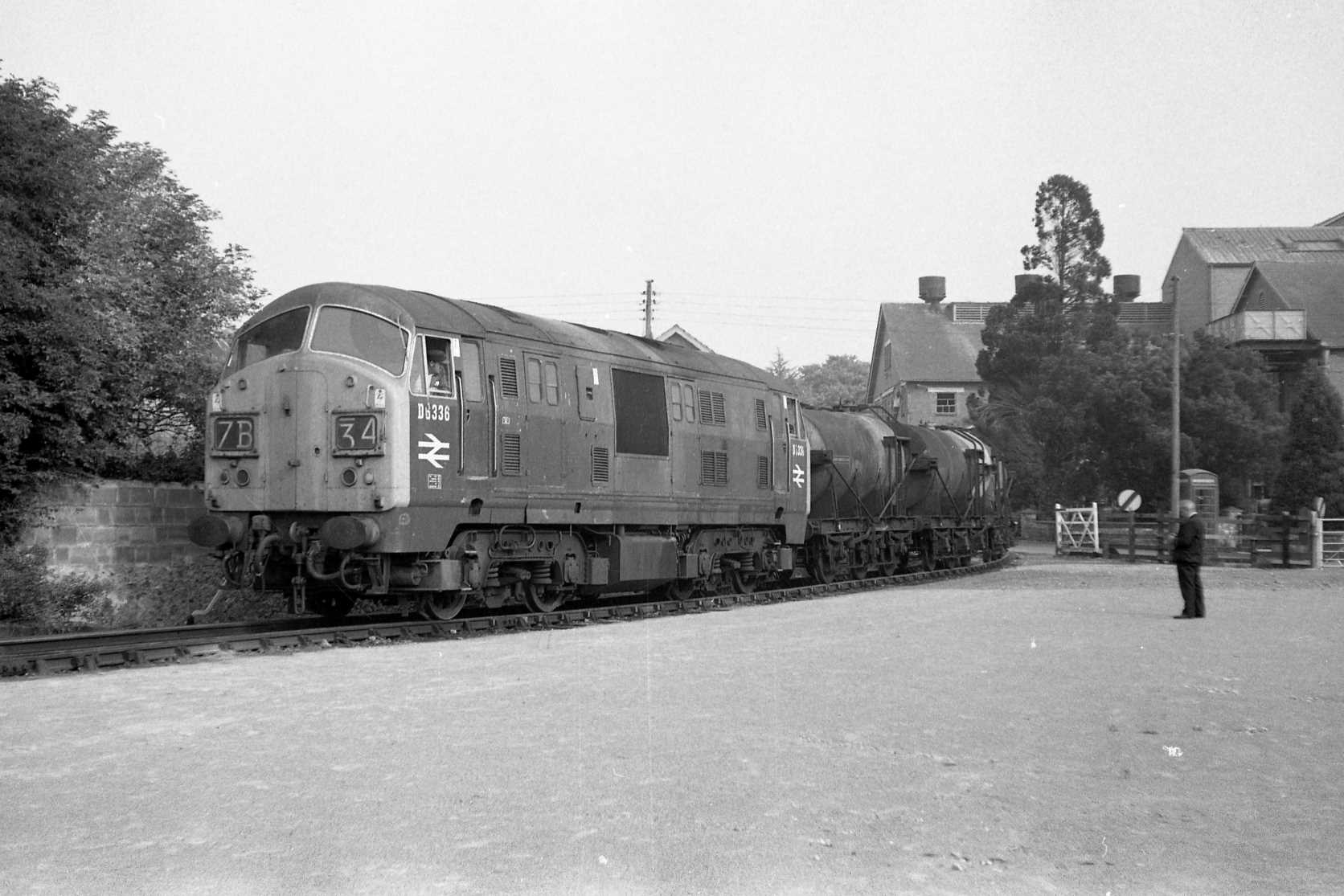Weekly Roundup – 15-Sep-24

A bit of a surprise on the first day of the WSR’s ‘FORTIES EVENT’ – Class 33 ‘Crompton’ D6575 (33057) was attached at the rear of the 10:40 Bishops Lydeard to Minehead service. The 1960’s loco was being moved to Minehead to provide cover for a steam loco that was giving a bit of trouble. In the end, the diesel was not needed until the following day. Pictured at Crowcombe Heathfield with WSR ‘Mogul’ 9351 on Saturday 14th September 2024 by Josh Brinsford © CC BY-NC 3.0
The WSR took on a 1940s look for the weekend of 14/15th September as each station along the line hosted a range of special activities with a 1940s theme, everything from unexploded bombs through to song and dance. The blue skies of the Saturday had clouded over by the Sunday, but the weather remained good and the event was very well attended, with several additional trains running and wartime goods trains adding to the interest on the Saturday.
On the Sunday, one of the steam locos developed a fault so the goods trains had to be cancelled and our Class 33 ‘Crompton’ D6575 (33057) was ‘requisitioned by the authorities’ and pressed into action on four passenger services, to ensure that the full published passenger service was provided. Very useful locos, these Class 33s !
DIESEL RUNNING DATES
Class 35 ‘Hymek’ D7017 will be hauling the BLUE timetable diesel turns on Saturday 21st and Sunday 22nd September with 80 miles of haulage available each day.
As the ‘Hymek’ is currently stabled at Williton, there will be a ‘Light Engine’ working on Saturday morning, leaving Williton at 0900 and arriving at Minehead at 0935 so that the ‘Hymek’ can take up position at the head of the 10:00 service to Bishops Lydeard.
Catching a ride behind D7017 will be Class 14 ‘Teddy Bear’ D9526 and Class 33 ‘Crompton’ D6566 (33048), both going to Minehead for different reasons. The ’14’ will position over the pit at Minehead so that an underframe inspection can be carried out. The ’33’ is fresh from an ‘A’ exam at Williton and will take over as Duty Loco from sister D6575 (33057) who will in turn catch a ride behind D9526 when she returns to Williton later in the day. These additional workings should make for some interesting photo opportunities. See our DIESELGEN bulletin for more details.
Keep an eye on our DIESEL RUNNING DATES page for details of diesel-hauled public services and sign up to our DIESELGEN email bulletin service to get advance notice of non-public service running.
Click here to go to our DIESEL RUNNING DATES page
Click here to go to our ONLINE SHOP
Thank you very much for your support !
LOCO NEWS:
Class 52 D1010 ‘WESTERN CAMPAIGNER’ – the hard work on the ‘B’ bogie resumed on Saturday 14th as the team, comprising Gordon, Ian F and Thomas, turned their attention to the equalising beams that distribute the weight between the outermost pair of axles in the bogie. The beams are hung from inverted ‘pedestals’ that are bolted into place within the bogie frame and are very difficult to access, especially when plastered with dirt and grease. After many hours spent cleaning and preparing, the retaining bolts on the pedestal bearings were eventually released and the first of the two equalising beams extracted. The associated pedestal was then easy to access and removal took a matter of minutes. Having done the first one, the others should be ‘easy’ ….. but everything is relative !
The general scheme of work on the ‘B’ bogie is as follows, with status information added:
- Remove the cardan shafts – 100% completed on 10th August
- Remove the brake rigging – 100% completed on 24th August
- Remove the primary springs – 100% completed on 24th August
- Remove the equalising beams and pedestals – 50% completed on 14th September.
- Remove the secondary springs
- Inspect the bogie frames, wheel bearings and gearboxes
- Replace the torque reaction rubbers
- Re-assemble using repaired or replacement parts as required.
As always, there is plenty to do on this massive locomotive, so please CONTACT US if you are a DEPG member and would like to come along to help.
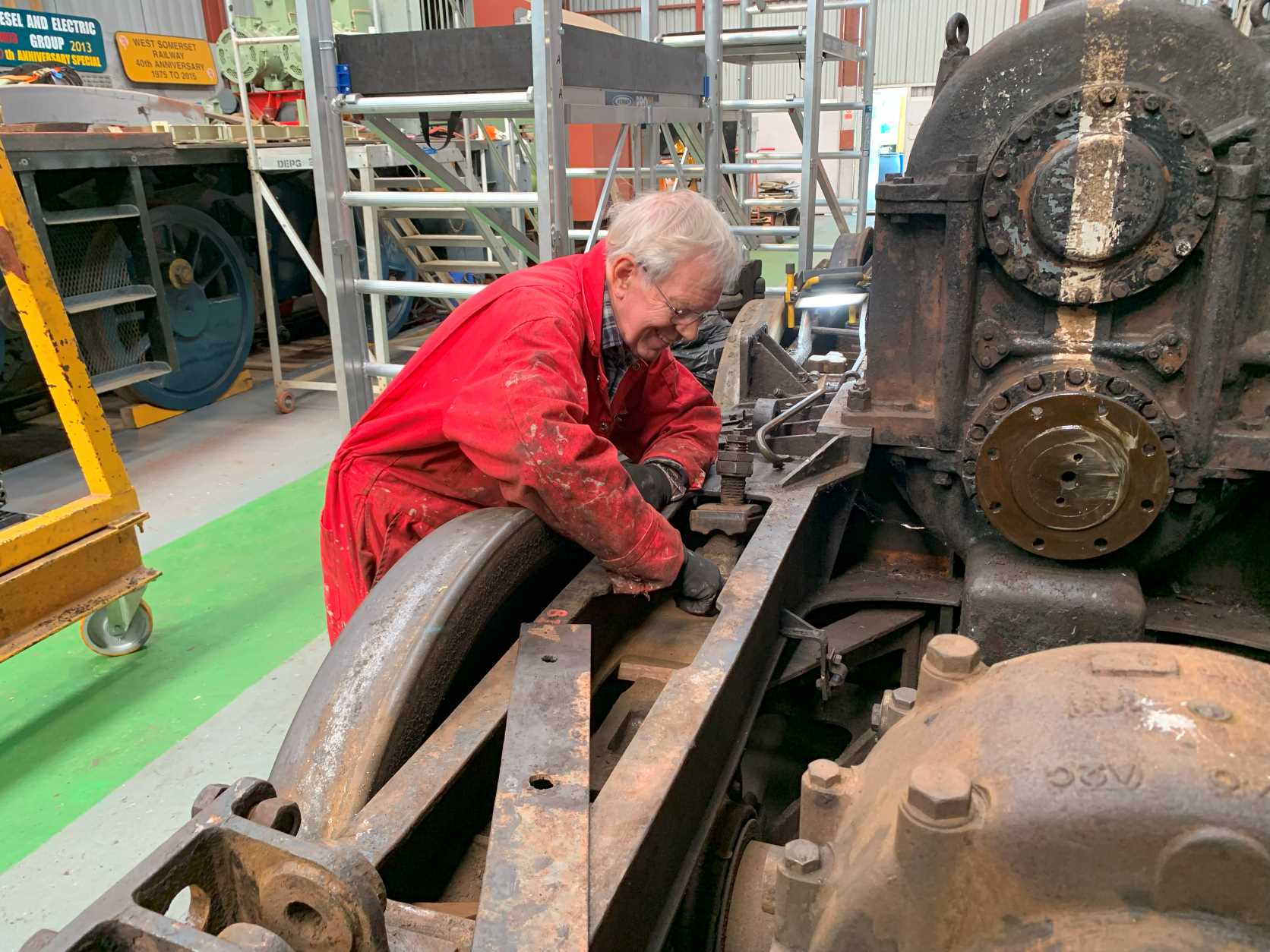
D1010 – volunteer Ian F was hard at work preparing for the extraction of the equalising beams of the ‘B’ bogie at Williton on Saturday 14th September 2024. Photo by Andy Royal © CC BY-NC 3.0
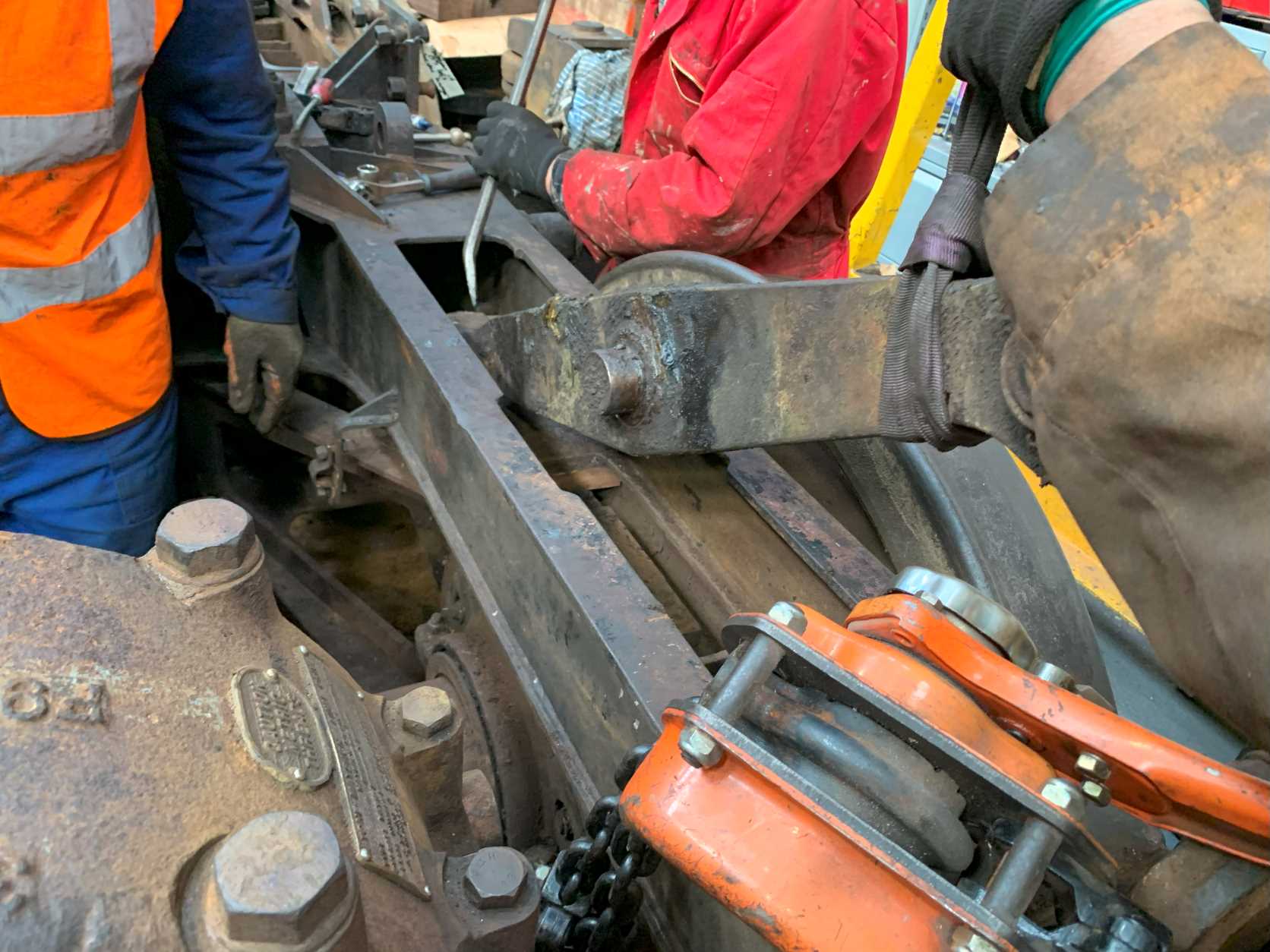
D1010 – the first of the two equalising beams of the ‘B’ bogie sees the light of day after 50+ years of being incarcerated inside the bogie frame. Pictured at Williton on Saturday 14th September 2024 by Andy Royal © CC BY-NC 3.0
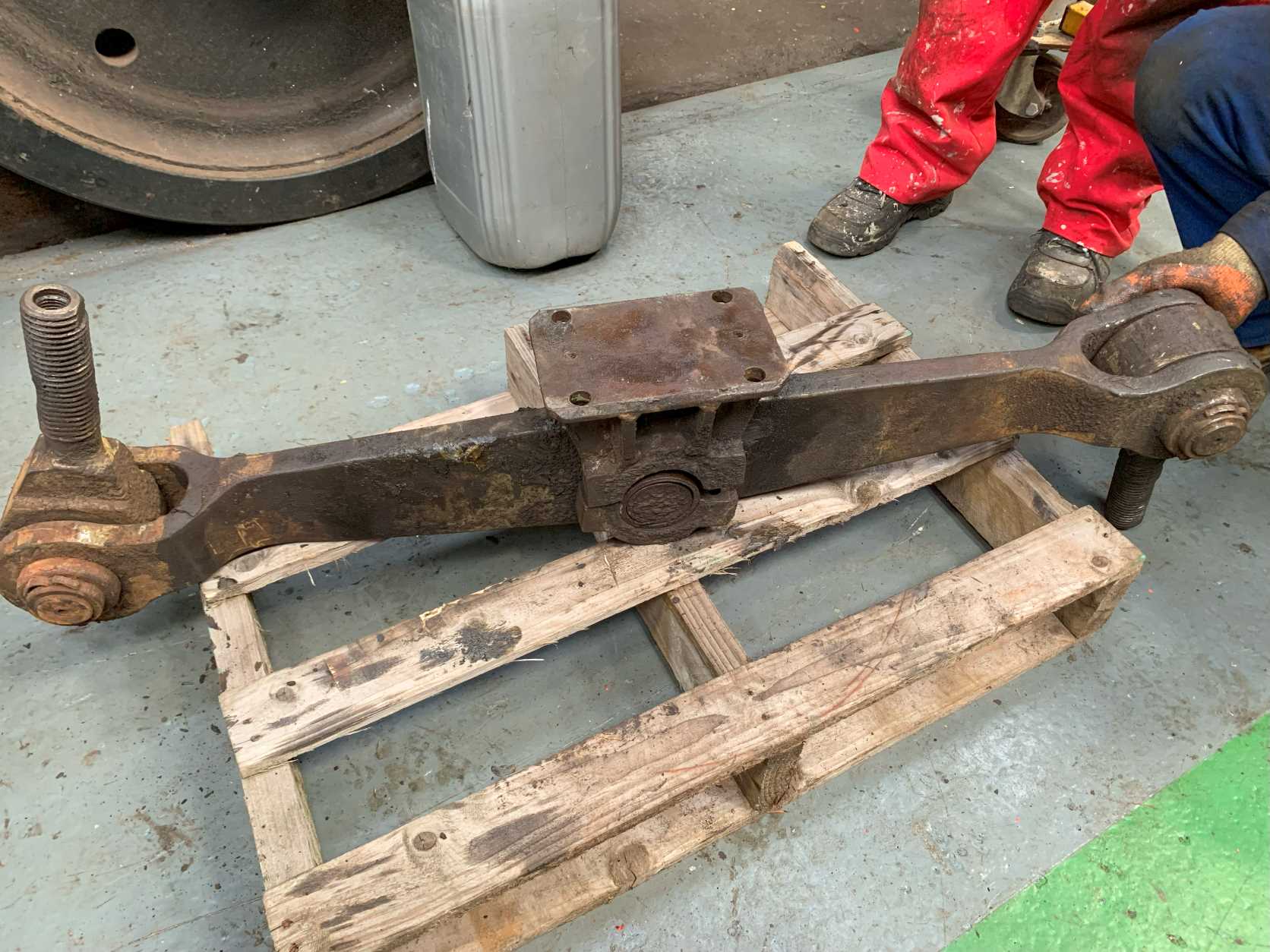
D1010 – and it’s out, complete with the ‘pedestal’ that allows it to pivot and transfer the load from one axle to another. The only issue is that it pivots a little too easily due to the amount of wear in the bearings. Some remedial work is required. Pictured at Williton on Saturday 14th September 2024 by Andy Royal © CC BY-NC 3.0
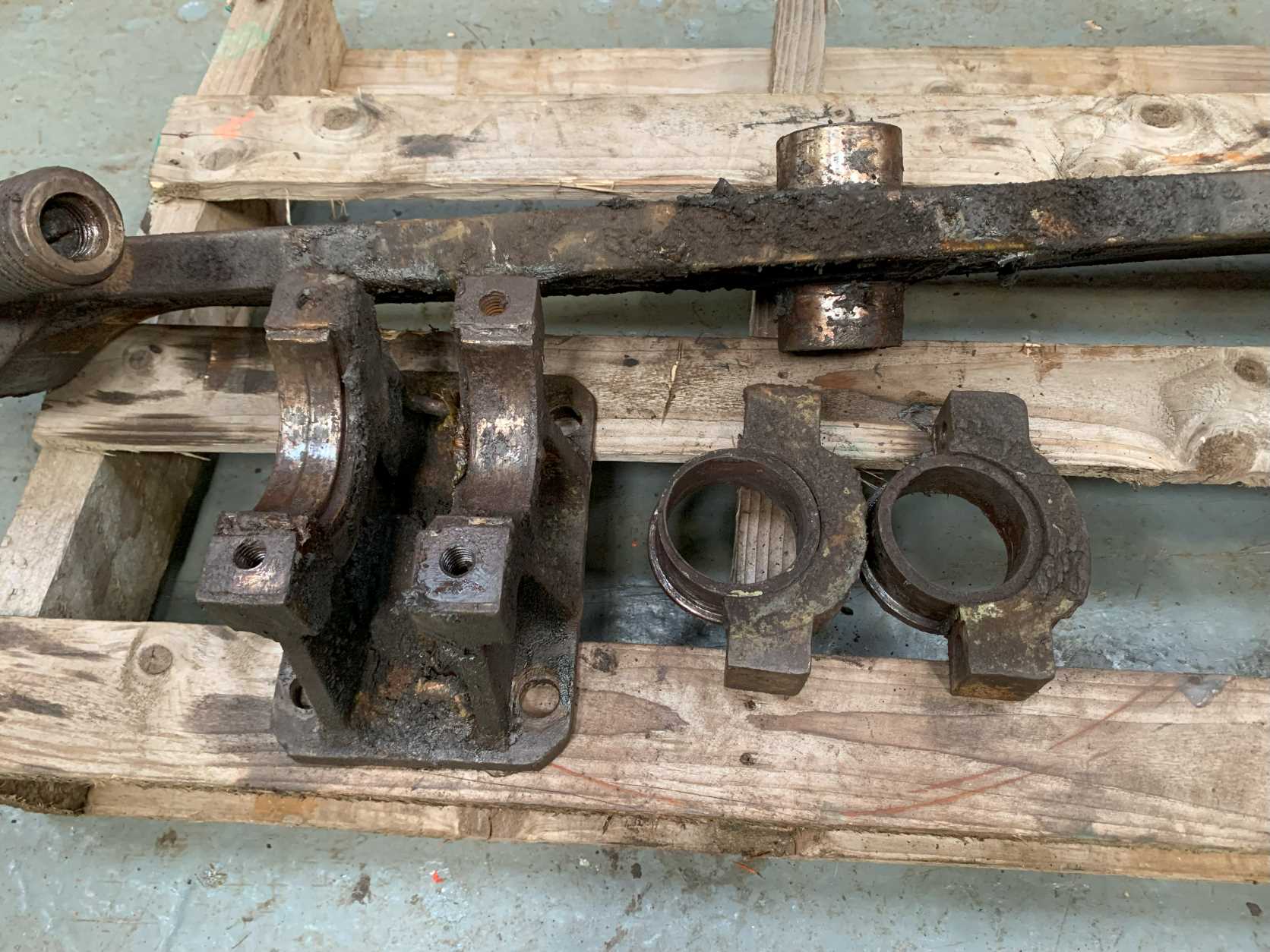
D1010 – the component parts of the ‘pedestal’ that sits inside the bogie frame and carries the equalising beam that transfers some of the load from one axle to another. Pictured at Williton on Saturday 14th September 2024 by Andy Royal © CC BY-NC 3.0
Please help us with this very important work by making a donation to the D1010 Restoration Fund and support the repair work that is taking place right now. Thank you in advance for your help.
We are still offering the SPONSOR A PATCH scheme where your name or message will be engraved into the metal of the loco body as acknowledgement of your donations to the D1010 RESTORATION FUND. We are a bit behind with the engraving but now that the loco body has been determined as safe to work on, we can resume the engraving and catch up. There is plenty more metal yet to be engraved, so GET YOUR SPONSORED PATCH BY CLICKING THIS LINK !
Class 09 D4107 (09019) – this loco is based at Bishops Lydeard and is in regular use in support of WSR activities. At the end of the season, she will move to Williton to undergo body repairs and a repaint, along with some other maintenance activities that are aimed at keeping her reliable and available for service.
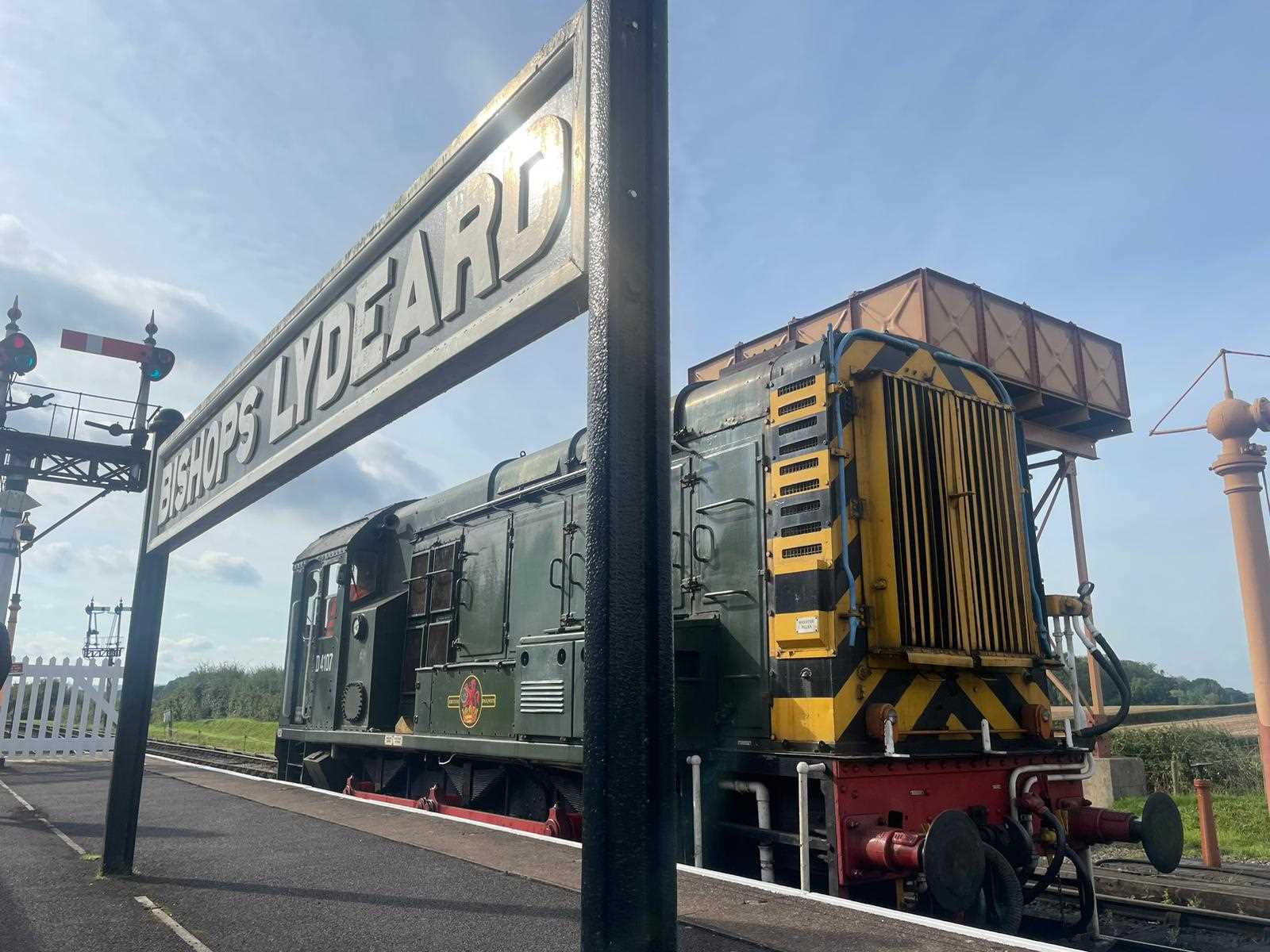
Class 09 Shunter D4107 (09019) was basking in the sunshine at Bishops Lydeard when pictured on Sunday 15th September 2024. Photo by Josh Brinsford © CC BY-NC 3.0
Class 33 D6566 (33 048) – This loco will take up the role of Duty Loco when she arrives at Minehead on Saturday 21st September. Her next booked duties are under the BLUE TIMETABLE on Saturday 28th and Sunday 29th September.
Class 33 D6575 (33 057) – this loco will return to Williton on Saturday 21st September to undergo an ‘A exam and several other items of planned maintenance.
Class 35 ‘Hymek’ D7017 – this loco is stabled at Williton and will be moving to Minehead to take up her duties on the diesel diagram of the BLUE TIMETABLE on Saturday 21st and Sunday 22nd September.
Click on this link or on the graphic below to visit our DIESEL RUNNING DATES page.
Class 35 ‘Hymek’ D7018 – our ‘transmission team’ were back in the saddle with immediate results on Monday and Tuesday 9th/10th September with an excellent balance of action and care. The photos show that the re-assembly of the transmission is moving forward, but with trial assembly of each stage to allow measurements to be taken and the necessary clearances obtained and verified. This careful approach will pay dividends and allow us to have the required level of confidence when we get to the testing phase in the near future.
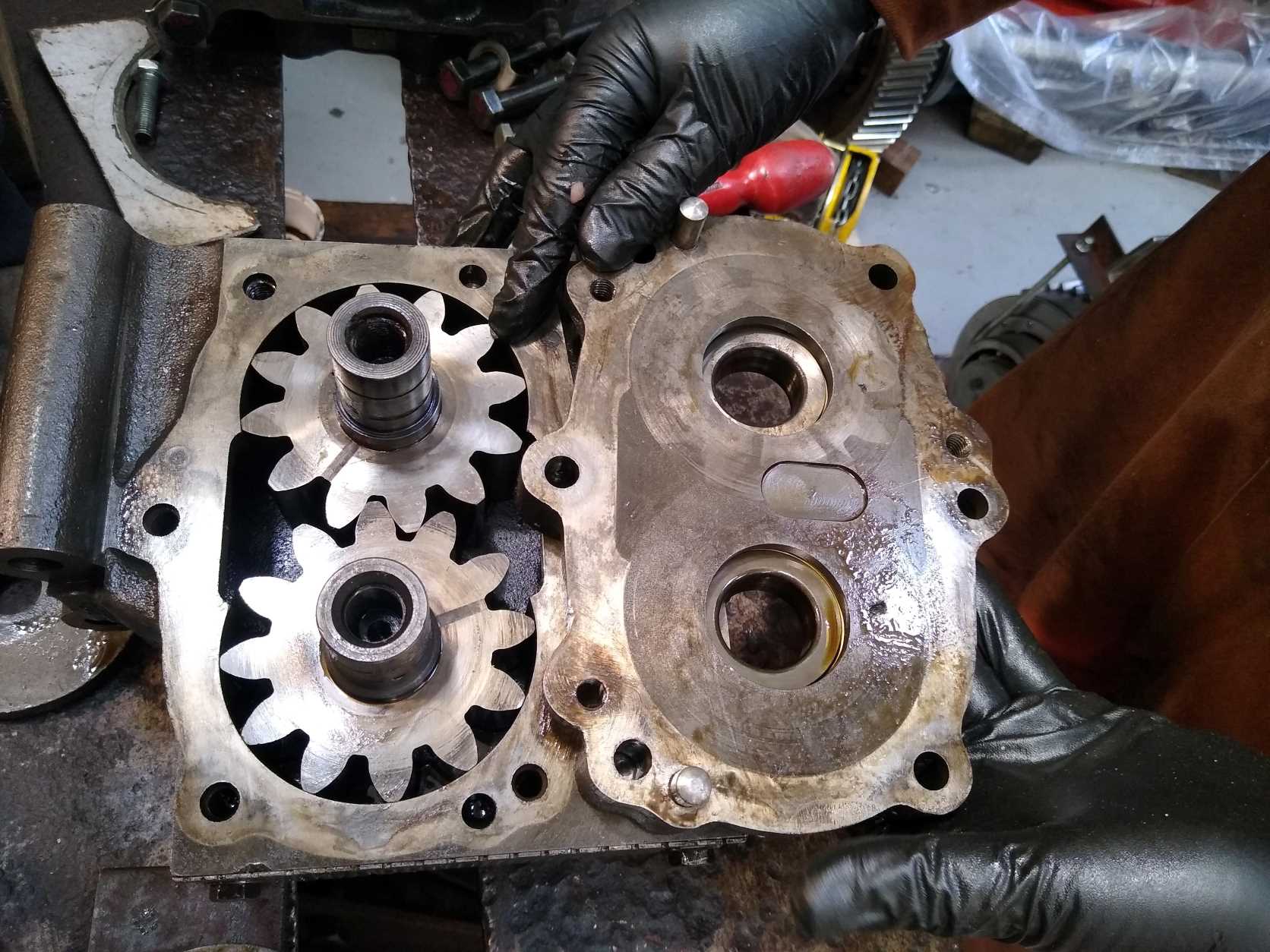
D7018 – the oil pump was disassembled to check for cleanliness and damage. Everything was OK but the bearings were not great so they were exchanged with those from the ‘good spare’. Pictured at Williton on Monday 9th September 2024 by Colin Foxhall © CC BY-NC 3.0
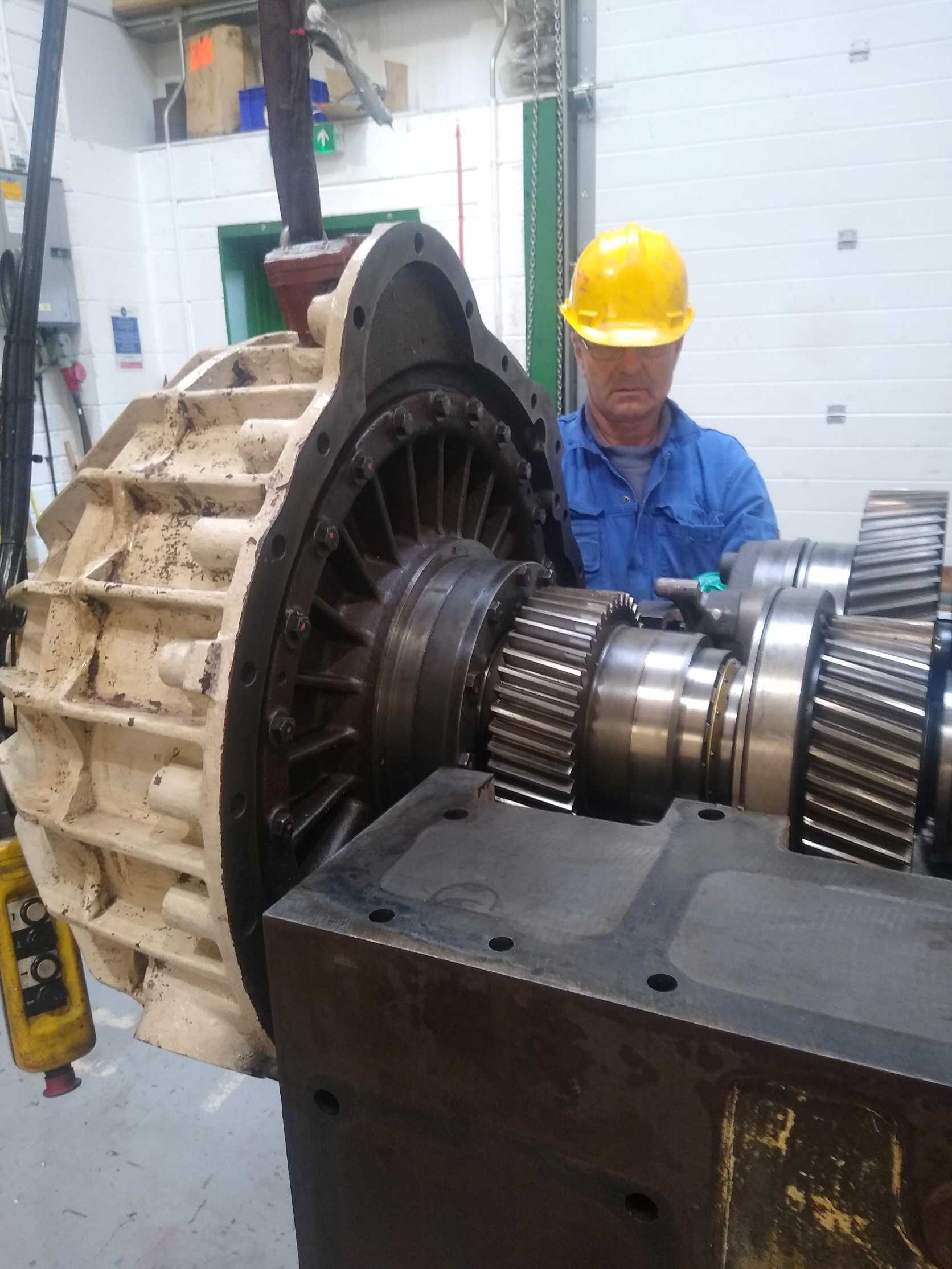
D7018 – the massive torque converter assembly was trial fitted to the primary geartrain shaft of the transmission at Williton on Tuesday 10th September 2024. Photo by Colin Foxhall © CC BY-NC 3.0
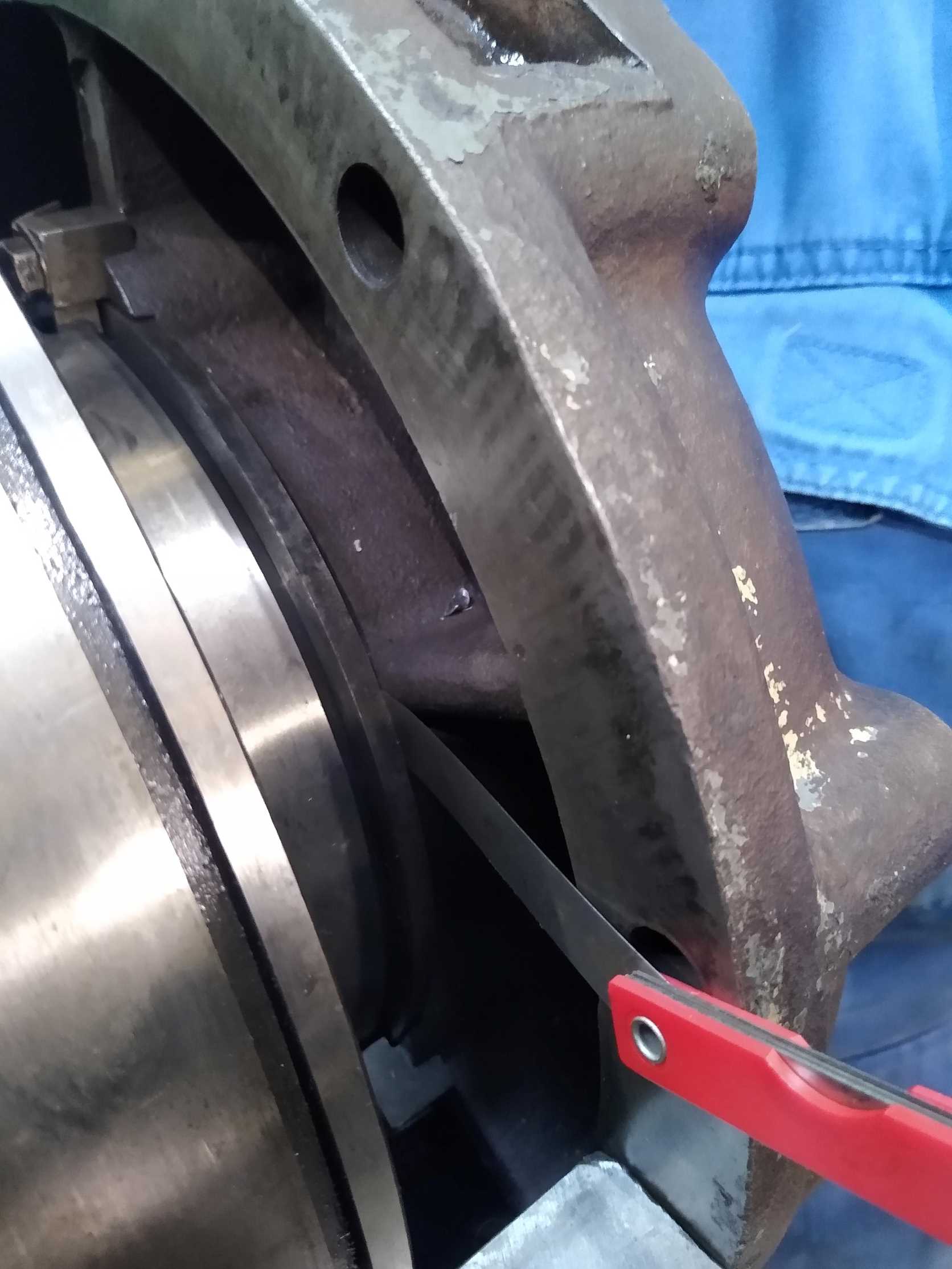
D7018 – having the torque converter in position allowed the end float of the primary geartrain shaft to be measured at the far end. Pictured at Williton on Tuesday 10th September 2024 by Colin Foxhall © CC BY-NC 3.0
Please help us with this very important work by making a donation to DEPG funds and allowing us to support the repair work that is taking place on D7018 right now. Thank you in advance for your help.
Class 14 ‘Teddy Bear’ D9518 – the team are powering ahead with the overhaul of the Paxman ‘Ventura’ 6YJXL engine that was previously installed in sister loco D9526. The pistons and cylinder liners were removed from the engine, exposing the crankshaft journals, all of which were in very good condition. Here are some photos:

D9518 – the six pistons from the Paxman ‘Ventura’ 6YJXL engine were removed and arranged on the steel table in front of the ‘Tuesday Team’ (L-R, Terry, Nick, Tony and Linda) at Williton on 10th September 2024. Photo by Mark Bladwell © CC BY-NC 3.0

D9518 – the six cylinder liners were also removed for inspection and to allow the sealing surfaces to be cleaned and inspected. So far so good ! Pictured at Williton on 14th September 2024 by Andy Royal © CC BY-NC 3.0
Click here or on the image below to make a donation towards the restoration of D9518. Thank you very much for your support !
Class 14 ‘Teddy Bear’ D9526 – this loco is moving to Minehead on Saturday 21st (along with ‘Hymek’ D7017) and will then position over the pit for an underframe exam and a brake adjustment. The loco will return to Williton later that same day, working ‘Light Engine’, with Class 33 D6575 (33057) in tow.
Class 47 47077 ‘NORTH STAR’ – this loco is based at Grosmont on the North Yorkshire Moors Railway but is currently out of service because of a coolant leak from the liner of cylinder B3. Only one of the 12 cylinders appears to be affected, but further investigations will be carried out as part of the repair work. A subcontractor has been engaged to allow the work to proceed quickly, and the completion date is scheduled for early October.
Andrew Barclay 0-4-0DH 578 – our loco may not have been used much during these last few weeks but her twin sister, number 579 (ROF 2), has been busy, moving ex-GWR coaches from Dunster sidings to the new West Somerset Railway Heritage Trust (WSRHT) workshop at Washford, where restoration can take place under cover. The moves were performed as ‘top-and-tail’ with Class 03 shunter D2133 at the rear and at walking pace, because these coaches have not moved in a very long time.
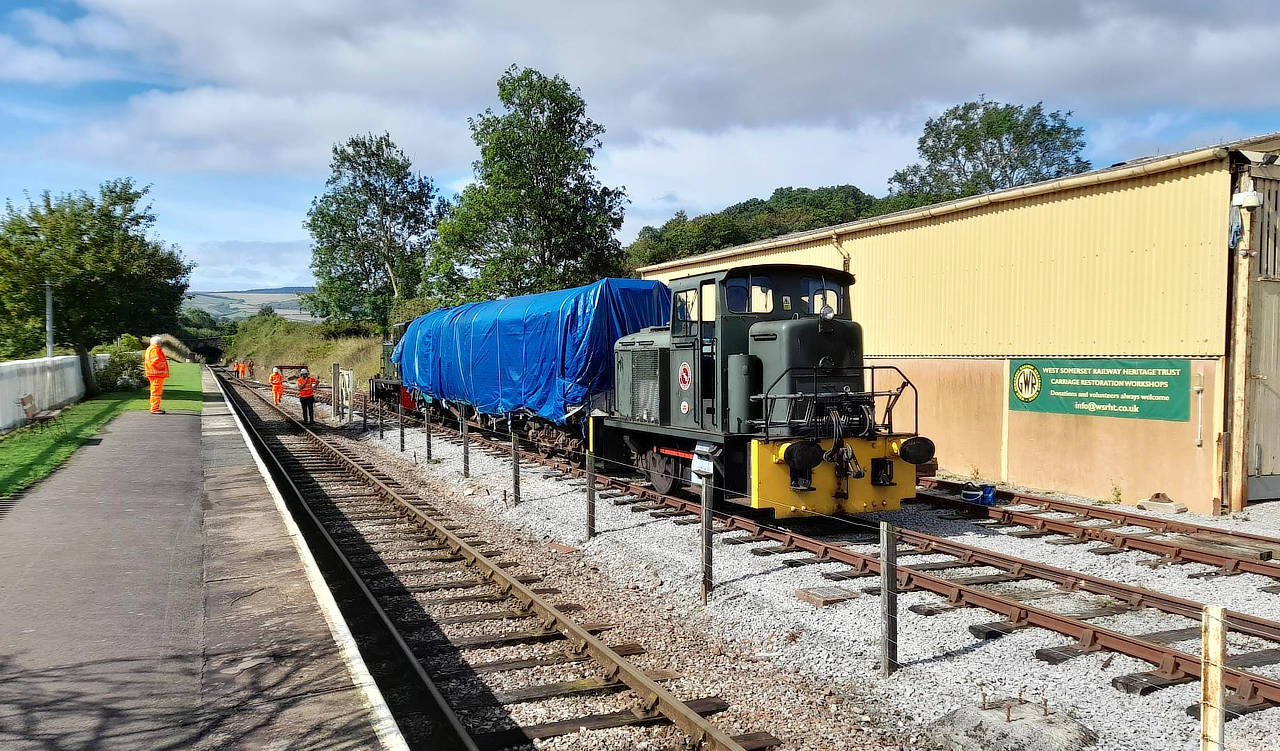
Barclay 579 (ROF2) was in use to haul several ex-GWR coaches from Dunster Sidings to Washford on Monday 9th September 2024. Each coach was moved separately at walking pace with the Barclay in the lead and Class 03 shunter D2133 at the rear. Photo by the WSRHT © CC BY-NC 3.0
BOOK REVIEW: with the closedown news from PROJECT 22 reported in the Roundup for 25-Aug-24 still fresh in our minds, we will continue to feature Anthony Sayer’s detailed analysis of the Class 22 for one more week and we will also include the Class in the ‘ON SHED’ feature further below. Both volumes of these books are in stock and ready for those who want to learn more about these extinct machines. Even though they were seldom at the top of the loco spotter’s list of favourites, they still have a right to exist and it is sad that not a single example of Classes 16, 21, 22, 29, 41 or 43 remain, a total of 164 main line locomotives that were built in Glasgow for BR by the North British Locomotive Company.
To find out more, consider purchasing VOLUMES 1 and 2 of THE NORTH BRITISH CLASS 22 by Anthony P. Sayer.
VOLUME 1 – Setting the Scene VOLUME 2 – Detailed Insights
Volume 1 tells the story of the origins and development of the NBL Class 22 locos, and covers each member of the class in some detail, in the usual style of the author. Volume 2 delves into their service record and extensive modifications list, ending with details on their final disposal. None were saved.
Highly recommended and offered at £26 per copy via the DEPG online store. Click here or on the image above to get your copy and in doing so, support the DEPG !
The DEPG 2025 CALENDAR is now available for mailing, comprising 14 printed pages of A3 (twice A4 size) glossy paper on a spiral wire binder. This calendar features the DEPG’s locomotives, both in service and in preservation, with all of the photos being provided by members and supporters. Click here or on the image above to GET YOUR COPY – WHILE STOCKS LAST – for £14 plus p&p.
ON SHED: one more photo on the Class 22 theme before we move on, again from regular contributor BARRY GAY, this one taken on a Wednesday afternoon in September 1971, almost exactly 53 years ago, at Hemyock, a villiage in the Blackdown Hills near the Devon-Somerset border, 5 miles south of Wellington. This was the terminus of a branch line from Tiverton Junction that had been built as the Culm Valley Light Railway back in 1876, and was kept alive until 1975 by the existence of a United Dairies creamery. Here are Barry’s words on the subject:
“D6336 shunting milk tanks at Hemyock on Wednesday, September 22, 1971. The Class 22 worked in with the empties from Exeter at 15.35, leaving with 5 full tanks at 16.30. The Hemyock and Torrington milk trains continued with Class 22s until the end of the year, in fact until Saturday, January 1, 1972 when D6339 worked the last Class 22-hauled Hemyock and D6333 the last Torrington. Both trains arrived at Exeter St Davids within 5 minutes of each other, uncoupled, with the locos going to Exeter stabling point where they were immediately withdrawn. The milk tanks would have been put on the 6A21 St. Erth-Kensington later that evening hauled by a Class 52 !!”
Many thanks to Barry for sharing his photos and his memories with us all.
North British Type 2 Class 22 D6336 was pictured on Wednesday 22nd September 1971 while shunting 6-wheeled milk tank wagons at Hemyock, the terminus of the 7.5 mile (12 km) Culm Valley branch line that joined the main Bristol to Exeter line at Tiverton Junction. Photo by Barry Gay © CC BY-NC 3.0
DEPG NEWS: last week’s roundup included a brief summary of the proceedings of the ANNUAL GENERAL MEETING (AGM) of the DEPG that took place at Williton on Saturday 7th September. A detailed report is being prepared and will be included in the next Newsletter. Any DEPG members who would like to receive the detailed report sooner or by email are invited to request a report by using our CONTACT FORM or emailing the subject ‘AGM REPORT‘ to contact@deg.org
The Financial Report for 2023 has now been filed with Companies House and the filing with the Charity Commission will be completed later this month (this must be done before 31st October).
The DEPG is a charity and is run entirely by volunteers, many of whom give both their time and their money to the continuance of work on the locos in the DEPG fleet. If you have been enjoying the roundup for free, have you considered joining us for just £1 a month ? You can then add your name to all of those helping out on the above projects and play your part in the future of our locos for a lot less than the price of a cup of coffee!
JOIN US using whichever membership class is appropriate for your situation and means. CLICK HERE or on the image below or use the QR code to get the details.
If you would like to go one step further and come along to help with the work on the locos in our fleet, then please use our CONTACT FORM to let us know that you would like to volunteer and we will respond with more details.
We look forward to hearing from you !










